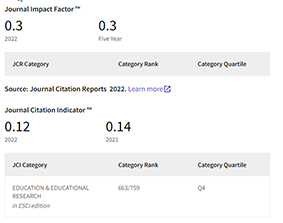The Residence for Women Students of Madrid in the Spanish Second Republic: between high culture and social splendor
DOI:
https://doi.org/10.14516/ete.2015.002.001.016Parole chiave:
Women’s Residence, Board for Advanced Studies and Scientific Research, Institución Libre de Enseñanza, María de Maeztu, Women’s education, Spanish Second RepublicAbstract
In October of 1915 the Board for Advanced Studies and Scientific Research (JAE) opens in Madrid the Women’s Group of the Students’ Residence, called Women’s Residence (Residencia de Señoritas), with the aim of being the home of women who visited Madrid for studying in University or for getting some culture. Women’s Residence, as well as Students’ Residence, was not only a convenient accommodation; following the inspiration of the Institución Libre de Enseñanza, it provided the residents with means of intellectual encouragement and moral improvement. The cultural and social activity of the Women’s Residence, ran by María de Maeztu, was outstanding in the twenties and in the Second Republic until the dramatic cut of the Civil War. This work analyzes the period between 1931 and 1936, using documentary of the Women’s Residence Archive, hemerographic sources of that time and bibliographic sources. The first two years of the Second Republic were vibrant; from 1933 on there is a trend towards to substitute cultural events for basic formative activities directed to non University women. Nevertheless, in the years previous to the Civil War, the Women’s Residence of Madrid was a privileged stage of conferences, soirées and courses of first level, unparalleled with any other women’s educational institution of the time.
Riferimenti bibliografici
Barga, C. (1931). Lo inesperado. Una misa negra en la Residencia de Señoritas. Crisol, Madrid, 27/10/1931.
Castillejo, J. de (1976). Guerra de ideas en España. Madrid: Ediciones de la Revista de Occidente.
López-Ríos Moreno, S. (2013). These Ladies Out-radical the Radicals: María de Maeztu, Victoria Kent and Victoria Ocampo. Bulletin of Hispanic Studies, nº 3, Liverpool University, pp. 331-346.
Morla Lynch, C. (2008). En España con Federico García Lorca. Sevilla: Renacimiento.
Pérez-Villanueva Tovar, I. (2011). La Residencia de Estudiantes 1910-1936: Grupo Universitario y Residencia de Señoritas. Madrid: Publicaciones de la Residencia de Estudiantes.
Porto Ucha, A. S. & Vázquez Ramil, R. (2014). María Montessori en la Residencia de Señoritas de Madrid (1934): entre la visita social y el esbozo de proyecto pedagógico. In Hernández Díaz, J. M. (coord.) & Hernández Huerta, J. L. (ed.), Influencias italianas en la educación española e iberoamericana (pp. 251-262). Salamanca: FahrenHouse.
Porto Ucha, A. S. & Vázquez Ramil, R. (2015). María de Maeztu. Una antología de textos. Madrid: Dykinson.
Serna, Víctor de la (1932). El poeta en Nueva York. El Sol, Madrid, 17/03/1932.
Vázquez Ramil, R. (2001). La Institución Libre de Enseñanza y la educación de la mujer en España: la Residencia de Señoritas. Betanzos (A Coruña): Lugami.
Vázquez Ramil, R. (2012). Mujeres y educación en la España contemporánea: la Institución Libre de Enseñanza y la Residencia de Señoritas de Madrid. Madrid: Akal.
Vázquez Ramil, R. (2014). La mujer en la II República española. Madrid: Akal.
Zulueta, C. de (1984). Misioneras, feministas, educadoras. Historia del Instituto Internacional. Madrid: Castalia.







